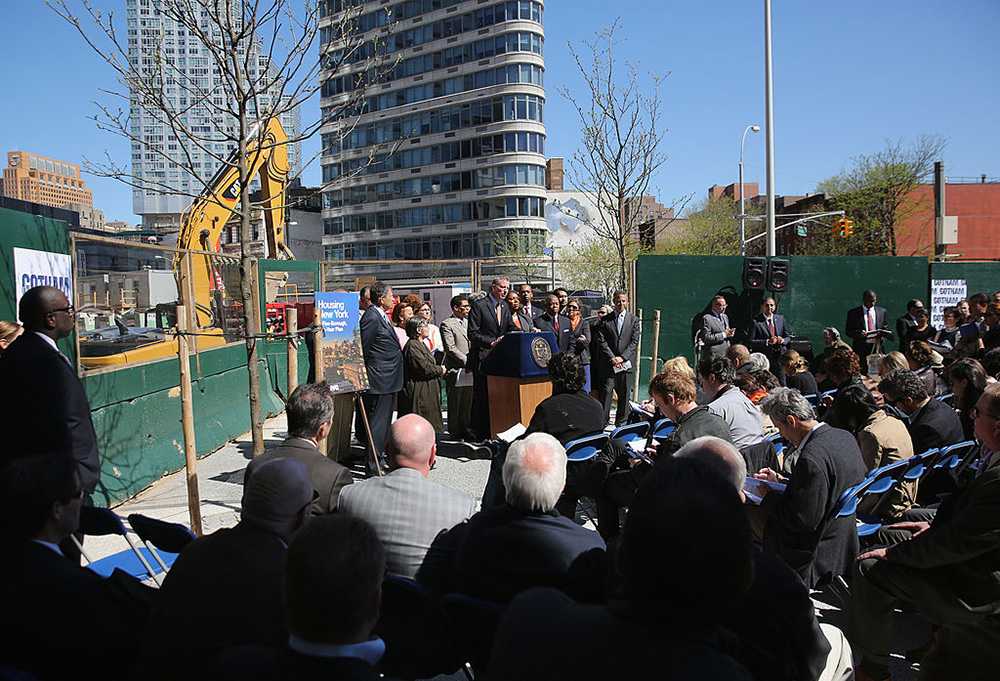He's counting units put in motion many years ago
Mayor de Blasio’s plan to build or preserve 200,000 units of affordable housing over 10 years ranks as one of his signature initiatives. As the late Mayor Ed Koch might have asked, “How’s he doing?”
Indeed, there is reason to conclude the mayor is exaggerating his accomplishments to date — by counting a fair number of projects initiated by his predecessor.
“A review of housing starts claimed by the administration on the NYC Open Data site reveals that a significant number appear to have been in the pipeline before the mayor took office.”
There is no doubt that the city has been well-organized in pushing for and publicizing progress toward the goals.
Housing New York, as the plan is known, has, it asserts, “financed 77,651 affordable homes since January 2014, including the highest three-year streak of affordable housing production in the city’s history.”
Although these include some 9,700 units priced for middle-income families (earning up to $141,000 annually), rents for a large majority are set, through subsidies for the private developers who own the buildings, for those earning less than $68,000, including 11,000 units for those earning less than $25,000.
There is more — or less — to all this than is apparent, however. A review of housing starts claimed by the administration on the NYC Open Data site reveals that a significant number appear to have been in the pipeline before the mayor took office.
These include the sprawling 1,093-unit Arverne View apartment complex in Far Rockaway, Queens. Severely damaged by superstorm Sandy, renovations were announced in November 2012 and completed in March 2014, just three months into the mayor’s term. Its developer, L+M Development Partners, notes that it “closed on the acquisition and construction financing in November 2012.” Including it among the administration’s totals is questionable, at best.
The same can be said for a number of other projects for which de Blasio takes credit. These include the 248-unit Livonia Commons project in East New York, Brooklyn — first announced by the Bloomberg administration in 2012, and Concern Bergen, a 90-unit supportive housing development in Brooklyn, whose sponsor listed it as being “in the pipeline” in its 2013 annual report, prior to the mayor taking office.
They also include Promenade Apartments, a 318-unit uptown complex whose owners announced, when it purchased the property in October 2013, that it planned to “maintain affordability (through) a 40-year regulatory agreement with the city Department of Housing Preservation and Development.”
The 136-unit Crossroads Plaza development in the Bronx, although opened in 2016, was long in the development pipeline as well. As the Mott Haven Herald reported in 2012, “In a deal that dates back to the days when Rudy Giuliani was mayor, the Bloomberg administration has continued to grant the three partners . . . exclusive rights to develop the site .”
It is difficult to determine exactly how many units classified by the de Blasio administration as counting toward its housing goal also date to previous administrations; city records list the sponsors of 129 affordable housing deals closed in the first six months of the de Blasio administration as “confidential.”
In fact, a review of affordable developments included in totals for the first six months of the administration finds at least 2,300 units which were in the pipeline before the mayor took office.
To be sure, these are not the only reasons for concern about the de Blasio policy. The resulting housing may be inexpensive for those tenants fortunate enough to hit the lottery held for such units — but they are not cheap in terms of public subsidy. Renovating Arverne’s 1,093 apartments cost $232.3 million, including $72 million financed by tax-exempt public bonds. That comes out to $212,000 per unit for a fortunate, but small, group of low-income households.
It’s not even clear whether, in some neighborhoods, it’s necessary to subsidize apartment rents in order to ensure their affordability. Many units whose affordability is being extended are in low-cost parts of the city. For instance, not far from the “preserved” affordable units of the Newport Gardens apartments on Lott Ave. in Brownsville, Brooklyn, a no-subsidized two-bedroom apartment was recently advertised for $1,450 a month — barely more than the nearby “affordable” rent in Newport Gardens of $1,348 per month.
The Housing New York Plan approach would be wise to compare market rents with “affordable” rents before making its investment decision — rather than focusing on preservation as an end in itself.
It’s worth keeping in mind a fundamental point. New York has far more public and subsidized housing as a portion of its housing stock — including more than 1 million rent-regulated units — than any other American city. And yet it always seems to have a housing affordability crisis. Bill de Blasio has not changed that.
This piece originally appeared in the New York Daily News
______________________
Howard Husock is the Vice President of Research and Publications at the Manhattan Institute. From 1987 through 2006, he was director of case studies in public policy and management at Harvard University’s Kennedy School of Government.
This piece originally appeared in New York Daily News
